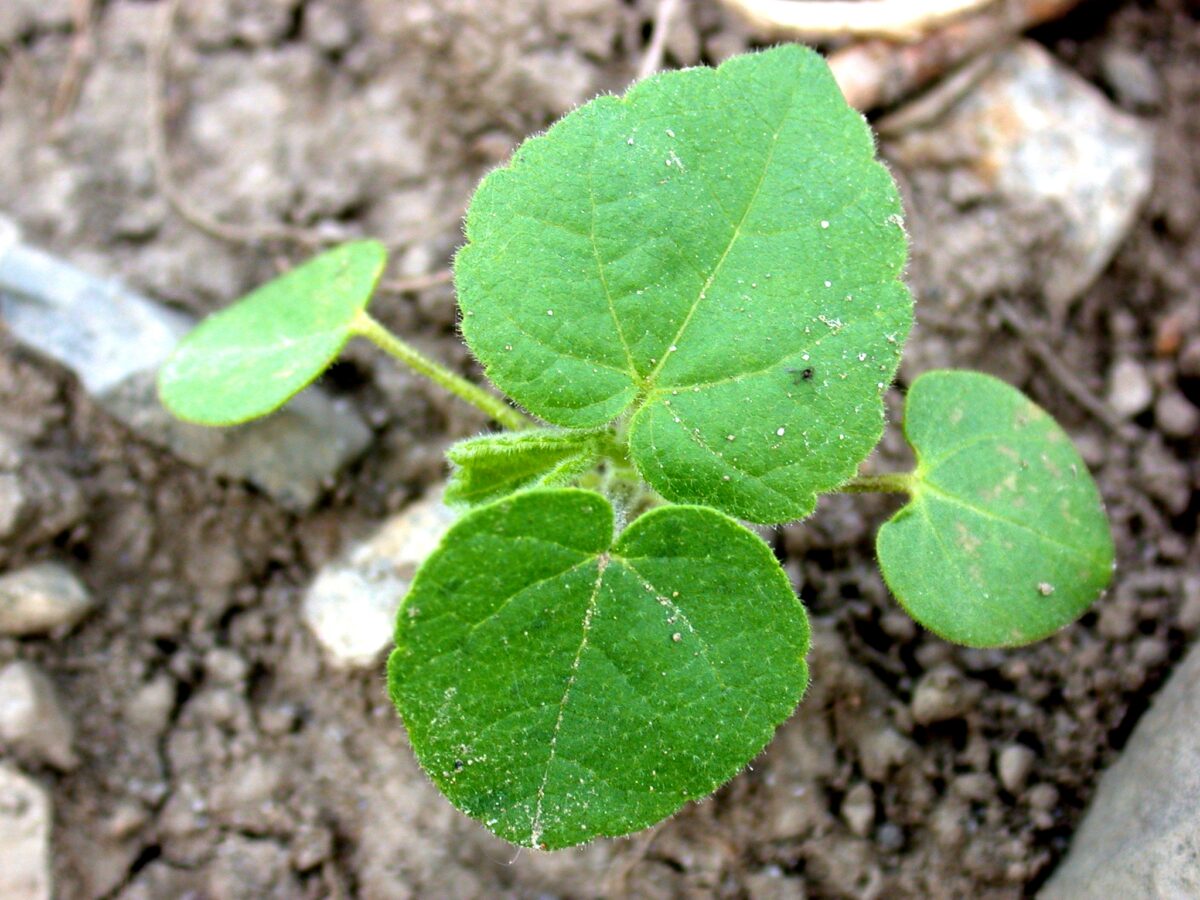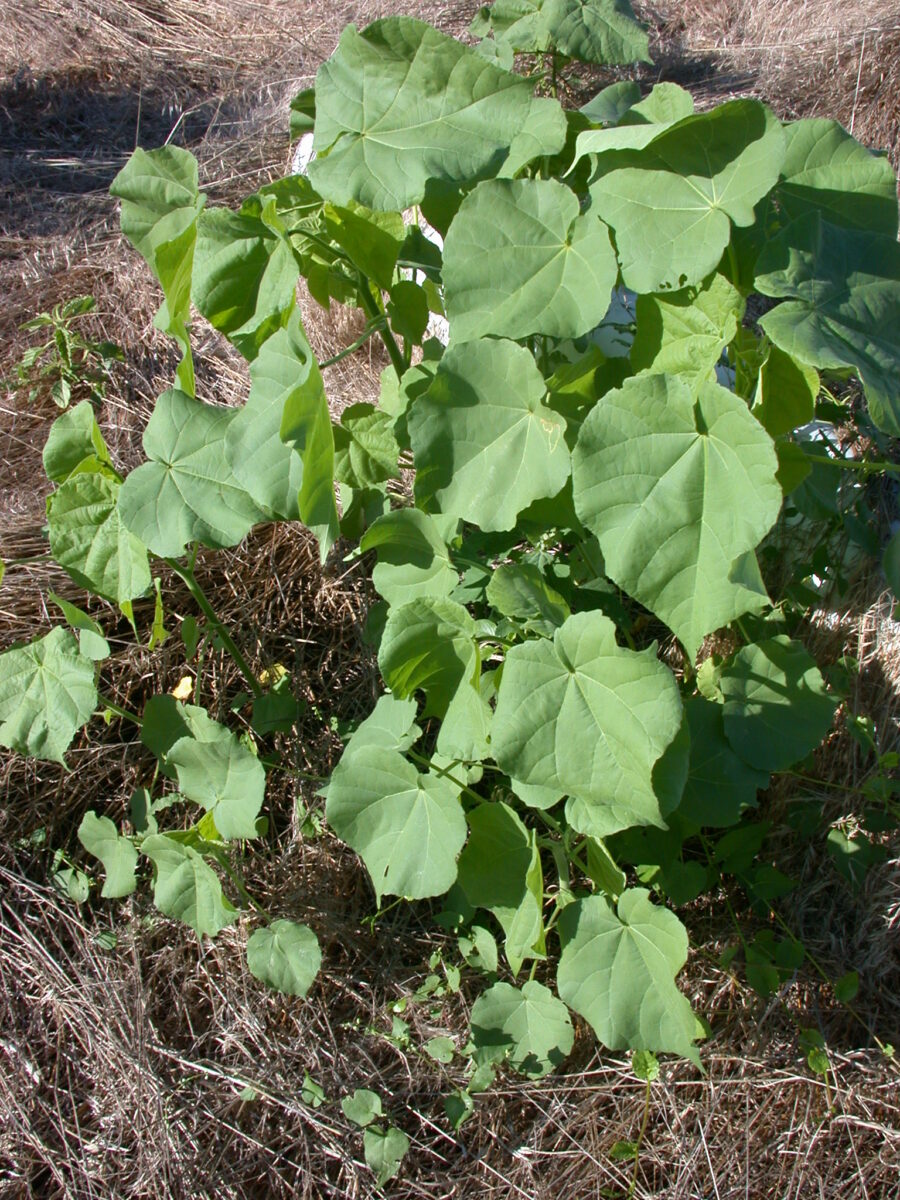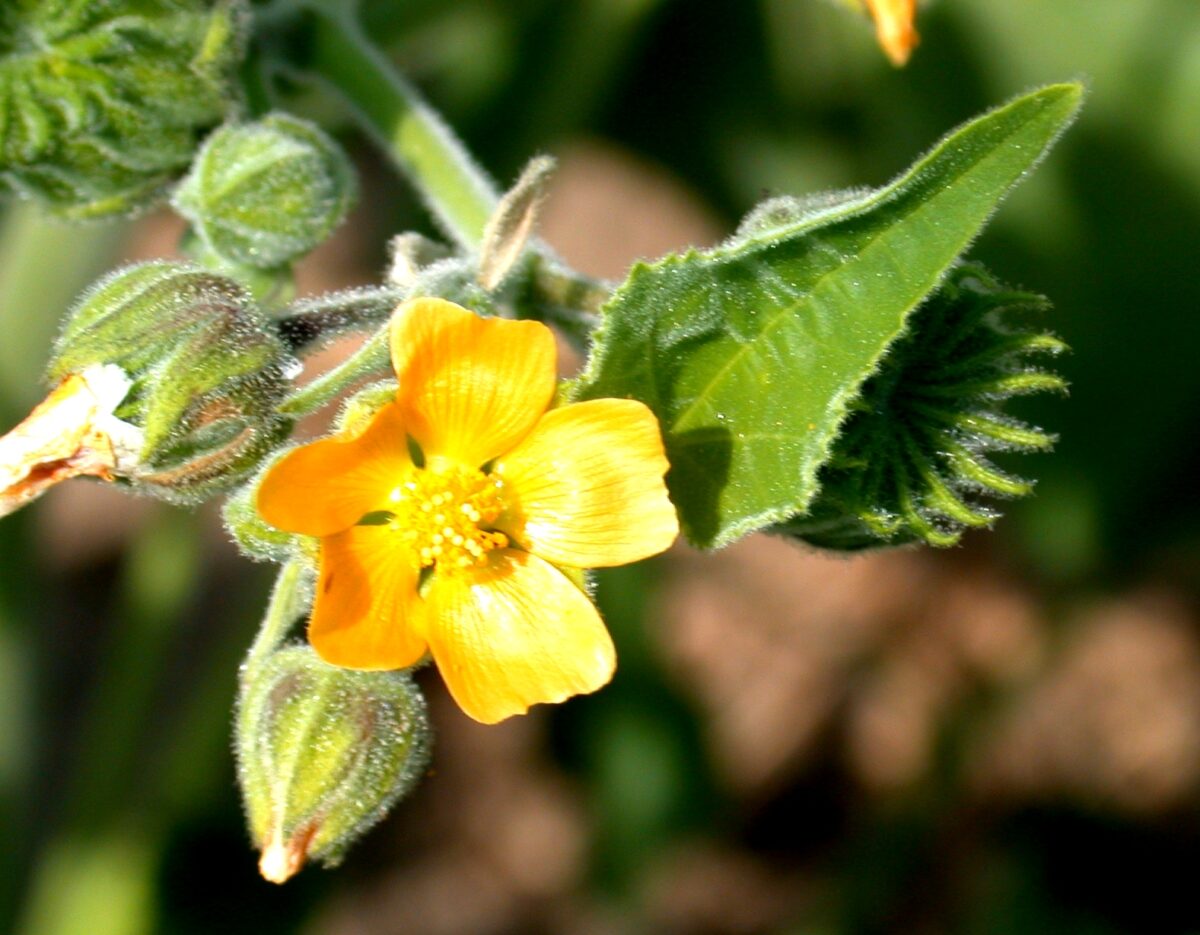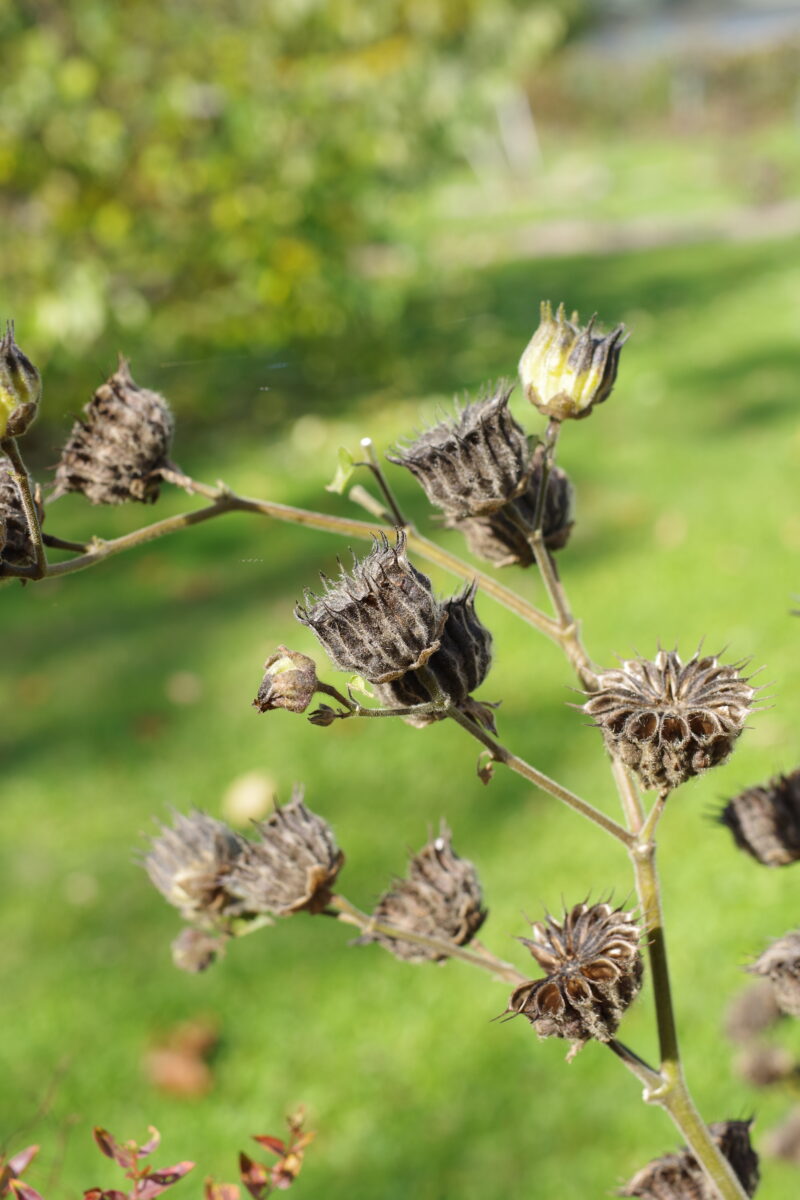Other common names: butter print, butter weed, pie marker, Indian mallow, velvet weed, Indian hemp, cotton weed, buttonweed, wild cotton, elephant ear, chingma, velvet leaf butterprint




Abutilon theophrasti Medik.
Identification of Velvetleaf
Family: Mallow family, Malvaceae
Habit: Tall, erect, summer annual herb
Description: The stem of the seedling is hairy. Cotyledons are heart shaped, 0.13–0.5 inch long and hairy on all surfaces, including the edge. The first true leaves are alternate, heart shaped, covered with soft hairs on both surfaces and have blunt teeth along the edges. Mature plants are 2–7 feet tall, with hairy stems that often branch towards the top of the plant. Leaves are alternate, densely covered in soft, fine hairs and are heart shaped with a tapered tip. Each leaf is 4–8 inches long and wide, with a 4–8 inch-long leaf stalk. Leaf edges are bluntly toothed. Prominent veins radiate from the point where the leaf stalk attaches. Leaf and stem tissue give off a distinctive odor when crushed. The root system is a shallow, branching, white taproot. The flowers are yellow to yellow-orange and grow from the upper leaf axils on 1–2 inch-long stalks. Each flower is 0.6–1 inch wide and has five green sepals and five shallowly notched petals. Flowers are replaced by circular, cup-shaped capsules composed of a ring of flattened, pointy tipped seedpods. The capsules are light green when young and become brown to black as they mature. Mature capsules may remain on dead stems throughout the winter. Each capsule contains 15–45 grey-brown, kidney to heart-shaped seeds. Each seed is 0.04–0.06 inch thick and 0.08–0.11 inch long and wide.
Similar species: Common mallow (Malva neglecta Wallr.), prickly sida (Sida spinosa L.) and Venice mallow (Hibiscus trionum L.) seedlings may sometimes be confused with velvetleaf. The cotyledons of all three species are hairless, however, while those of velvetleaf are covered in fine hairs. The first true leaves of common mallow are rounded rather than heart shaped, like velvetleaf, while prickly sida’s true leaves are more oval in shape and have larger teeth than those of velvetleaf. The first true leaves of Venice mallow are irregularly shaped, and all subsequent leaves are divided into three or more distinct lobes.
Management of Velvetleaf
Velvetleaf is primarily a pest in long season, spring planted row crops like corn and soybeans, and rotating away from these crops helps manage the weed. Most velvetleaf emerge in the spring, so delaying planting or rotating to a summer planted crop allows destruction of many seedlings by tillage and a reduction in velvetleaf density in the crop. Also, plants are usually not as competitive in summer planted crops due to more rapid initiation of reproduction in response to shortening day length. Velvetleaf generally does not begin setting seeds until late summer. Consequently, early harvested crops like winter or spring grains or peas interrupt this weed’s life cycle. In spring/early summer row crops, a good, uniform stand and a vigorous crop are critical, since crop competition can greatly decrease branching and seed production of velvetleaf.
A comparison of several studies on competition between corn and velvetleaf showed that velvetleaf caused little yield loss in years with cool weather (lower than 58°F average temperature) during the first two weeks after planting. In years with warm weather after planting, velvetleaf was only moderately competitive if the weather was wet during the period of rapid corn growth (30–75 days after planting), but it caused large yield losses if the weather was dry during that period. Thus, early season control of velvetleaf is particularly important in years with warm spring weather.
Velvetleaf seedlings can emerge from deep enough in soil that many will survive tine weeding or rotary hoeing. Consequently, you should target these operations against the white thread stage. This may entail more frequent cultivation with these implements than you would use against a more slowly establishing weed like common lambsquarters or redroot pigweed. Very shallow cultivation that cuts the plant just below or even at the soil surface causes high mortality of both seedlings and larger plants.
Both rodents and insects consume large numbers of velvetleaf seeds on the soil surface, and germinating seeds on the soil surface are prone to drying out before they become rooted. Consequently, if you have a year with high seed production of this species, avoid fall tillage to allow these mortality factors time to operate. A large percentage of velvetleaf seeds will germinate immediately following burial, so plowing to place surface seeds too deep for successful emergence will eliminate a substantial portion of the surface seed bank. However, seeds that do not immediately germinate will likely persist for many years and emerge following subsequent tillage events.
Because the seeds are relatively large, velvetleaf can emerge through even thick layers of organic mulch material. However, velvetleaf establishment was consistently suppressed when soybeans were grown in a rye cover crop left on the soil surface without tillage compared to soybeans that were planted after rye was incorporated by tillage. Velvetleaf seeds are exceptionally resistant to heat, and solarization only slightly reduces the survival of velvetleaf seeds.
Ecology of Velvetleaf
Origin and distribution: Velvetleaf is native to Asia and was introduced to the United States from China as a fiber crop during the colonial era. It subsequently spread throughout the United States and southern Canada. It has also been introduced into Europe.
Seed weight: Seed weights range from 6–12 mg, but most population mean seed weights are near 9 mg.
Dormancy and germination: When shed from the parent plant, 3–62% of velvetleaf seeds are dormant due to a hard seed coat that is impermeable to water. The percentage of hard seeds produced varies greatly between populations. Also, seeds produced in a shady environment have thinner seed coats and a substantially lower percentage dormancy. Although non-dormant seeds could potentially germinate in the fall, most do not due to unfavorable soil conditions, and many of these germinate the following spring. As dormant seeds age, the pore where the seed attaches to the parent plant eventually cracks open and allows water to enter and germination to proceed. This leads to sporadic germination over many years. The seed coat contains germination inhibitors, but these appear to be unimportant in maintaining dormancy in the field. A few seeds will germinate at 46°F, but germination is best at 75–86°F and declines above 95°F. Above 122°F, seed coat permeability increases and so does seed mortality. Temperature fluctuations do not promote germination, but a period of drying at a warm temperature (93°F) after exposure to moisture does. Natural chilling of seeds during the winter has little effect on germination. Light does not affect germination of fresh seeds but promotes germination of seeds that have been buried in the soil. Germination of velvetleaf seeds in the soil is inhibited by volatile organic compounds like ethanol and acetaldehyde that are produced during anaerobic respiration. This may partially explain why tillage, which vents these compounds to the atmosphere, can prompt a flush of emergence. Application of nitrate does not increase seed germination. The large seeds of velvetleaf require good soil-seed contact to germinate, and consequently germination is best in a fine seedbed.
Seed longevity: Velvetleaf seeds can persist in the soil for several decades. Mortality rates for undisturbed seeds range from 11–17% per year over three- to six-year periods. Experiments using locally collected seeds from several Midwestern states, however, found an average seed loss of 41–43% over the first year for shallowly buried seeds. When soil has been tilled annually, seed mortality rates of 32–53% per year have been observed. A demographic study found that 71% of the seeds in the seed bank in the previous fall were lost by the following spring. One year mortality of seeds decreased from an average of 55% at the soil surface to 3% at 6 inches. Mice consume 31–99% of seeds left on the soil surface over the winter, with mortality rate increasing with the amount of cover. Although velvetleaf seeds are highly persistent, a partial draw-down of the seed bank can be achieved over several years if seed production is prevented, and this can result in reduced seedling emergence in the crop.
Season of emergence: Velvetleaf emerges primarily in mid-spring, but a few seedlings emerge sporadically later in the growing season.
Emergence depth: Seedlings emerge best from the top 0.5–1 inch, while emergence is more variable from the top 2–3 inches of soil, and only a few emerge from below 3 inches. Emergence is poor from seeds on the soil surface.
Photosynthetic pathway: C3
Sensitivity to frost: Velvetleaf is killed by the first hard frost.
Drought tolerance: Velvetleaf is drought tolerant. In drought conditions it loses the lower leaves, which reduces water use and aides survival to reproduction. However, corn uses water more efficiently than velvetleaf and consequently can grow faster when water is in short supply.
Mycorrhiza: Velvetleaf is mycorrhizal, and the importance of mycorrhizae for phosphorus nutrition of this species has been demonstrated.
Response to fertility: Velvetleaf growth is highly responsive to fertilization, especially fertilization with N. Applications of poultry manure compost or blood meal continued to increase productivity up to 320 pounds per acre of N. Adding swine manure at rates of 500–643 pounds per acre of N plus 105 pounds per acre of N chemical fertilizer more than doubled seed production relative to 132 pounds per acre of N of chemical fertilizer alone. In a pot experiment, plants continued to increase in size and seed production up to 440-880-440 pounds per acre of N-P-K. Seedlings from plants grown in highly fertile conditions are larger and more competitive than those from plants grown at lower fertility.
Soil physical requirements: Velvetleaf tolerates poor drainage and a wide range of soil textures.
Response to shade: Velvetleaf is moderately shade tolerant. Shade at 30% only slightly decreased growth, but 76% shade reduced plant weight and seed production by 88% or more. Velvetleaf growth and seed production declined linearly as shading from a corn leaf canopy increased. Because shade and crop competition have relatively small effects on plant height, velvetleaf is often able to grow up into or to overtop crop canopies.
Sensitivity to disturbance: Velvetleaf can tolerate up to 75% defoliation at six weeks after emergence with little effect on plant size or seed production, provided the plants are not shaded. The substantial root system and fibrous stems of large velvetleaf plants make them difficult to uproot with cultivation.
Time from emergence to reproduction: Velvetleaf flowers in response to short days, so spring emerging individuals require more time to flower than summer emerging plants. Spring emerging plants in Wisconsin and Ontario flowered 11–12 weeks after emergence. Flowers pollinate the day they open. A few seeds become viable 12 days after flowering and essentially all are viable within 15 days, but capsules do not open to disperse seeds until 18–23 days after flowering. Flowering and seed production continue until frost.
Pollination: The species is primarily self pollinated, but some cross pollination by insects probably occurs.
Reproduction: The number of seeds produced is proportional to the weight of the plant. Plants typically produce 70–200 capsules, each containing 35–45 seeds. Plants grown without crop competition typically produce 700–17,000 seeds, but much lower seed production has also been observed. Crop competition can substantially reduce seed production, but velvetleaf growing in corn can still produce 1,000–2,000 seeds per plant in favorable circumstances.
Dispersal: Much feed corn is contaminated with velvetleaf seeds. These pass readily through the digestive tracts of livestock and are spread with manure. Seeds also pass intact through the guts of some birds or are regurgitated after being retained for several days, so dispersal by birds seems likely. Dispersal also occurs with soil clinging to tires and tillage implements. Combines probably also spread the weed between fields and farms.
Common natural enemies: Scentless plant bugs (Niesthrea louisianica) attack young pods and seeds and can substantially reduce reproduction both by direct damage and by introducing pathogens. Carabid ground beetles, slugs, cutworms and especially mice eat a substantial percentage of the seeds after dispersal, which reduces seedling density the next year. Fusarium lateritium wilt disease reduced velvetleaf growth by as much as 86% and resulted in up to 55% mortality of velvetleaf seedlings. The fungus Colletotrichum coccodes reduces plant growth and reproduction and has been tested as a biological control agent. Velvetleaf in organic corn fields in New York are often heavily attacked by a species-specific white fly that greatly damages the leaves, both directly and by introducing a virus. Damage to the velvetleaf may be so extensive that only a few individuals along the field edges reach maturity.
Palatability: The seeds are eaten as food in China and Kashmir. Some sheep find velvetleaf palatable while others reject it.
Note: Velvetleaf has allelopathic effects on some crops.
Summary Table of Velvetleaf Characteristics
| Velvetleaf | ||||||||
|---|---|---|---|---|---|---|---|---|
| Growth habit | Seed weight (mg) | Seed dormancy at shedding | Factors breaking dormancy | Optimum temperature for germination (F) | Seed mortality in untilled soil (%/year) | Seed mortality in tilled soil (%/year) | Typical emergence season | Optimum emergence depth (inches) |
| tall, erect | 6–12 | Variable | scd | 75-86 | 3–17 | 32–53 | mid-spring | 0.5–1 |
| Photosynthesis type | Frost tolerance | Drought tolerance | Mycorrhiza | Response to nutrients | Emergence to flowering (weeks) | Flowering to viable seed (weeks) | Pollination | Typical & high seed production (seeds per plant) |
| C3 | low | high | yes | high | 11–12 | 2 | self | 1,000 & 10,000 |
Table Key
General: The designation “–” signifies that data is not available or the category is not applicable.
Growth habit: A two-word description; the first word indicates relative height (tall, medium, short, prostrate) and second word indicates degree of branching (erect, branching, vining).
Seed weight: Range of reported values in units of “mg per seed.”
Seed dormancy at shedding: “Yes” if most seeds are dormant when shed, “Variable” if dormancy is highly variable, “No” if most seeds are not dormant.
Factors breaking dormancy: The principle factors that are reported to break dormancy and facilitate germination. The order of listing does not imply order of importance. Abbreviations are:
scd = seed coat deterioration
cms = a period subjected to cold, moist soil conditions
wst = warm soil temperatures
li = light
at = alternating day-night temperatures
ni = nitrates
Optimum temperature range for germination: Temperature (Fahrenheit) range that provides for optimum germination of non-dormant seeds. Germination at lower percentages can occur outside of this range. The dash refers to temperature range, and the slash refers to alternating day/night temperature amplitudes.
Seed mortality in untilled soil: Range of mortality estimates (percentage of seed mortality in one year) for buried seeds in untilled soil. Values were chosen where possible for seeds placed at depths below the emergence depth for the species and left undisturbed until assessment. Mortality primarily represents seed deterioration in soil.
Seed mortality in tilled soil: Range of mortality estimates (percentage of seed mortality in one year) for seeds in tilled soil. Values were chosen for seeds placed within the tillage depth and subjected to at least annual tillage events. Seed losses are the result of dormancy-breaking cues induced by tillage, germination and deterioration of un-germinated seeds.
Typical emergence season: Time of year when most emergence occurs in the typical regions of occurrence for each weed. Some emergence may occur outside of this range.
Optimum emergence depth: Soil depths (in inches below the soil surface) from which most seedlings emerge. Lower rates of emergence usually will occur at depths just above or just below this range.
Photosynthesis type: Codes “C3” or “C4” refer to the metabolic pathway for fixing carbon dioxide during photosynthesis. Generally, C3 plants function better in cooler seasons or environments and C4 plants function better in warmer seasons or environments.
Frost tolerance: Relative tolerance of plants to freezing temperatures (high, moderate, low).
Drought tolerance: Relative tolerance of plants to drought (high, moderate, low).
Mycorrhiza: Presence of mycorrhizal fungi. “Yes” if present; “no” if documented not to be present, “unclear” if there are reports of both presence and absence; “variable” if the weed can function either with or without, depending on the soil environment.
Response to nutrients: Relative plant growth response to the nutrient content of soil, primarily N, P, K (high, moderate, low).
Emergence to flowering: Length of time (weeks) after emergence for plants to begin flowering given typical emergence in the region of occurrence. For species emerging in fall, “emergence to flowering” means time from resumption of growth in spring to first flowering.
Flowering to viable seed: Length of time (weeks) after flowering for seeds to become viable.
Pollination: “Self” refers to species that exclusively self-pollinate, “cross” refers to species that exclusively cross-pollinate, “self, can cross” refer to species that primarily self-pollinate, but also cross-pollinate at a low rate, and “both” refers to species that both self-pollinate and cross-pollinate at relatively similar rates.
Typical and high seed production potential: The first value is seed production (seeds per plant) under typical conditions with crop and weed competition. The second value, high seed production, refers to conditions of low density without crop competition. Numbers are rounded off to a magnitude that is representative of often highly variable reported values.
Further Reading
Davis, A.S. and K.A. Renner. 2007. Influence of seed depth and pathogens on fatal germination of velvetleaf (Abutilon theophrasti) and giant foxtail (Setaria faberi). Weed Science 55: 30–35.
Oliver, L.R. 1979. Influence of soybean (Glycine max) planting date on velvetleaf (Abutilon theophrasti) competition. Weed Science 27: 183–188.
Teasdale, J.R. 1998. Influence of corn (Zea mays) population and row spacing on corn and velvetleaf (Abutilon theophrasti) yield. Weed Science 46: 447–453.
Warwick, S.I. and L.D. Black. 1988. The biology of Canadian weeds. 90. Abutilon theophrasti. Canadian Journal of Plant Science 68: 1069–1085.

